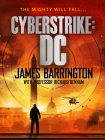Cyberstrike, James Barrington [short story to read .TXT] 📗

- Author: James Barrington
Book online «Cyberstrike, James Barrington [short story to read .TXT] 📗». Author James Barrington
North ignored even the cut-down panel in front of him because none of the displayed information meant anything to him and none of it would help him in his present predicament. He didn’t need to know things like airspeed or altitude because he could see all he needed to through the helicopter’s windscreen.
And what he could see was that it was in more or less level flight. If it was still going down the rate of descent had slowed, and it didn’t seem to be moving forward very quickly, so he guessed the Eurocopter was almost hovering. That at least gave him a bit of breathing space to sort out what to do next. Like how to get it down.
There were numerous buttons and controls on both the collective and the cyclic, he noticed, and he guessed that one of them probably worked the radio, but he had no idea which one. And talking to somebody on the ground wouldn’t help him very much at that moment. If he was going to walk away from this he’d have to land the helicopter himself.
North kept a firm grip on the collective and moved the cyclic very gently forward. The Eurocopter responded by moving ahead. He pulled back and moved it to the left. He knew what the helicopter would do, but he was just trying to get a feel for the way it responded, to gauge how much pressure he needed to exert to achieve a certain degree of movement. It felt controllable in a somewhat uncontrolled way.
He put his feet on the two rudder pedals and applied gentle force to the left-hand one as he turned the aircraft. That made the turn smoother, but right then he wasn’t interested in smoothness, only in getting the thing on the ground.
Next, he lowered the collective lever very slightly and felt more than saw that the aircraft was starting to lose height.
‘You can do this,’ he murmured to himself, though he was way out of his depth and he knew it.
North knew that the way helicopters landed wasn’t to descend vertically from height but to fly towards the designated landing area, losing height all the time, making an approach not unlike that of a fixed-wing aircraft, and then air-taxi before coming to a hover over the landing spot and vertically descend the last few feet to the ground. He was going to have to try to do that, but on his own terms.
He couldn’t risk maintaining the present heading because that was taking him towards a hangar and other buildings, so he put a little more pressure on the collective to stop his slow descent and moved the cyclic and the rudder pedal so that the aircraft was pointing towards one of the runways. If he cocked up his landing out there in the wide-open space of the airfield, at least he wouldn’t end up crashing into one of the buildings and taking anyone else with him.
North gently released some of the pressure on the collective to re-start his descent and held the cyclic as straight as he could. He picked a space a few hundred yards away, more or less in the middle of the runway, and aimed the helicopter straight for it. He kept the speed down, still trying to get a feel for the aircraft’s handling.
He felt the Eurocopter yaw to the left and corrected the movement as gently as he could but ended up swinging it to the right. He was being careful with the controls but guessed that he was repeatedly over-correcting, so he tried to relax and let the aircraft stabilise itself.
North remembered hearing a pilot tell him years earlier that if you went hands-off in a fixed-wing aircraft nothing would happen: it would just keep on flying at the same height and in the same direction at the same speed. But if you did the same thing in a helicopter, absolutely anything could, and probably would, happen and you needed to fly hands-on all the time. Not a particularly encouraging thought in his present situation.
He adjusted the position of the collective when it looked to him as if he was going down too slowly. He didn’t want to overshoot the runway and end up on the grass, though he assumed it was probably stabilised to cope with additional weight in case an aircraft ran off the edge of the asphalt.
He guessed he was only about one hundred feet above the ground, and still descending. His entire attention was focused on what he was doing.
Without his headset, the noise in the cockpit was uncomfortably loud, but there was nothing he could do about that. The runway stretched out below him, getting closer all the time as he tried coordinating the movements of the cyclic and the rudder pedals to keep the aircraft pointing straight ahead while still gently lowering the collective.
The runway surface seemed to rush towards him as he covered the last few feet in descent.
At the last second he pulled up on the collective to reduce the aircraft’s downward movement. That caused the helicopter to lurch to one side – probably because he’d applied too much force – and for an instant he feared it was going to topple over, though the logical part of his brain told him it couldn’t do that because the rotor was on top of the fuselage and mechanically that couldn’t happen.
North had been holding the helicopter in a slightly nose-down position and the nosewheel of the Eurocopter hit the runway first. The aircraft bounced back up into the air, the lurch causing the two mainwheels to bounce off the runway as well.
But that was good enough, and he was near enough, so North lowered the collective lever all the way down. With another bump the helicopter settled onto all three wheels of the undercarriage more or less in the middle of the runway. He slumped





Comments (0)